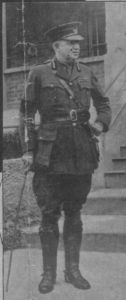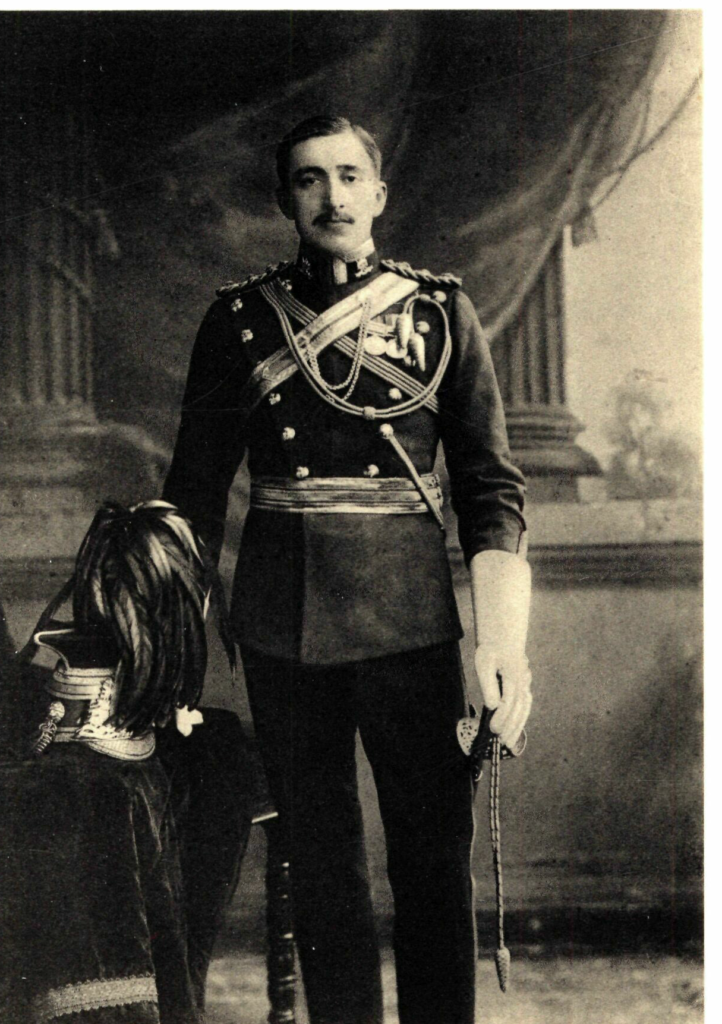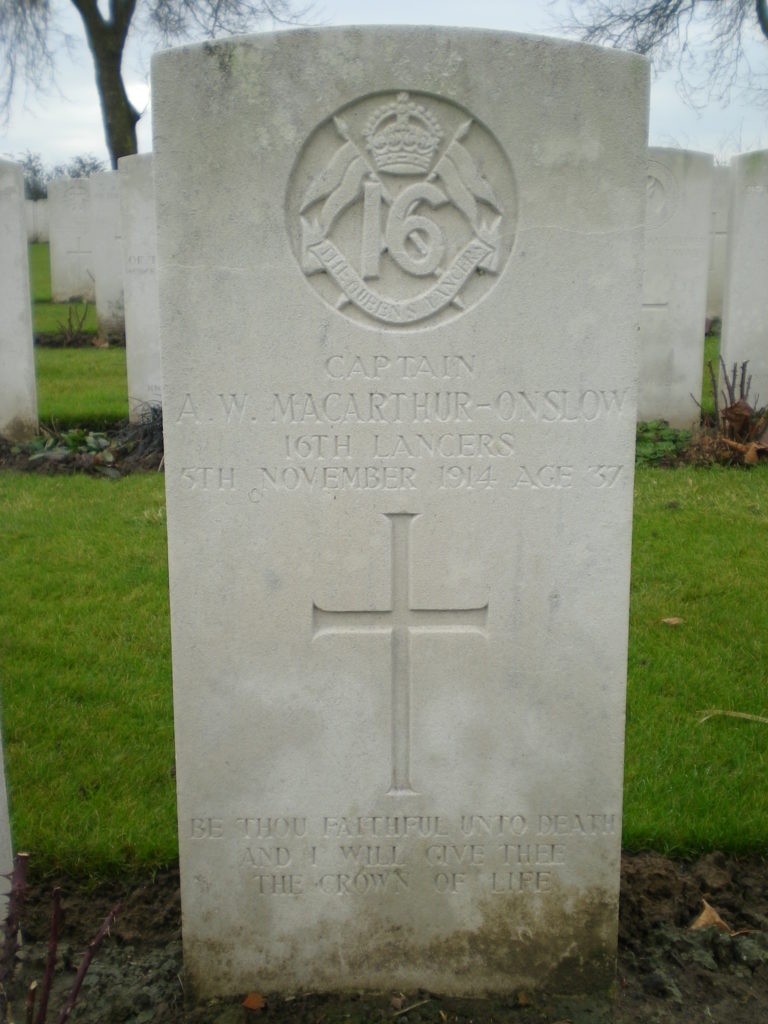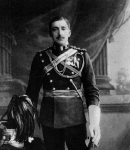Fact file:
Matriculated: 1896
Born: 27 May 1877
Died: 5 November 1914
Regiment: 18th (The Queen’s Own) Lancers
Grave/Memorial: Wulverghem–Lindenhoek Road Military Cemetery: 3.C.4
Family background
b. 27 May 1877 at Camden Park, near Menangle, New South Wales, Australia, as the fourth son (sixth child) of Captain Arthur Alexander Walton Onslow, RN (Retired) (1833–82) and Mrs Eliza Elizabeth Onslow (née MacArthur, Macarthur-Onslow by Royal Licence from 12 March 1892) (1840–1911); married 1867, Camden Park, Menangle, New South Wales.
Parents and antecedents
Macarthur-Onslow’s father was a professional naval officer from 1847 to 1871 and then, from 1869 to 1880, became a politician who represented Camden as an independent candidate in the New South Wales legislative assembly (1869–80). He was not independently wealthy, and on his death left goods valued at a mere £500 (approximately £20,000 in 1905). Macarthur-Onslow’s mother was, however, the granddaughter of Captain John Macarthur (1767 [Plymouth]–1834) and his wife Elizabeth Macarthur (née Veale) (1766–1850) (m. 1788), who arrived at the settlement in New South Wales called Port Jackson (now Sydney Harbour) in June 1790. Originally a professional soldier, by 1801 Macarthur was the largest rearer of sheep in New South Wales, and he is credited with introducing the (originally Spanish) Merino sheep into Australia, being the founding father of Australia’s wool trade, and setting up the 20,000 acre Camden Park Estate. Being an only daughter and a shrewd businesswoman, Macarthur-Onslow’s mother not only inherited the Camden Park Estate, she expanded and developed it, and made it the centre of Australia’s wool, wheat, dairy, horticultural and wine-growing industries. After her husband’s death, she took her six surviving children to Europe for the sake of their education, and while there, she studied modern methods of dairy farming in both Italy and England. In 1889 she returned to Australia, where, armed with this new knowledge, she set up a dairy-farming complex on the Camden Park Estate, which then sold its dairy produce on the nearby Sydney market. In 1899 she turned the estate into a private company, with her children as its shareholders and directors. Her efforts increased and consolidated the family fortune, and on her death in 1911, which occurred while she was visiting England to attend Arthur William’s wedding, she left £196,668 (approximately £8,000,000 in 2005).
Siblings and their families
Brother of:
(1) James William, MP (later Major-General) (1867–1946); married (1897) Enid Emma Macarthur (1868–1952); one son, two daughters;
(2) Emily Susan (1869–76);
(3) Rosa Sibella (1871–1943);
(4) Arthur John (“Jack”) (1873–1953); married (c.1902 in Victoria) Christian Leslie Bell (died 1946); one son, two daughters;
(5) George Macleay (later Brigadier-General) (1875–1931); married (1909) Violet Marguerite Gordon (1878–1981); one daughter;
(6) (Francis) Arthur (1879–1938); married (1903) Sylvia Seton Raymond Chisholm (1881–1950); three sons, one daughter;
(7) Alexander Norman (c.1882–83).
James William was educated at Sydney Grammar School and Trinity College, Cambridge (BA, LLB, 1890), returned to Australia in 1891 and became a professional soldier. In February 1892 he was commissioned Captain in the Camden Squadron of the New South Wales Mounted Rifles; in 1894–95 he was selected for special training in India with the 11th Hussars, the Royal Artillery, and the 1st Battalion, the King’s Royal Rifle Corps, in which he served during the expedition to relieve Chitral (1895), a tiny kingdom in Northern Pakistan on the Sino-Afghan border. He was promoted Major in February 1896 and in 1897 he accompanied a detachment of Mounted Rifles to England to take part in the celebrations of Queen Victoria’s Diamond Jubilee. In April 1898 he was promoted Lieutenant-Colonel.
During the South African War he went as a Special Service Officer to Cape Town at his own expense, arriving on 11 April 1900. After a period on the staff of the 7th Division, he served, from June to October 1900, as aide-de-camp to Lieutenant-General Sir Edward Hutton (1848–1923), the first Commander of the Australian Army (1901–04). He then paid a brief visit to England and returned to Australia in March 1901. In July 1902 he commanded the 5th Battalion, the Australian Commonwealth Horse, when it visited Durban, not long before the Battalion was disbanded in August. For service in the Second Boer War he received the Queen’s Medal (four clasps) and was mentioned in dispatches. From 1902 to 1909 he was aide-de-camp to the Governor-General, and having commanded the 2nd Light Horse Regiment from July 1903 onwards, he was promoted Colonel of the 1st Light Horse Brigade in December 1907. From January 1910 he was on the Unattached List. He was aide-de-camp to the Governor-General for a second time from 1917 to 1920, and in 1925 he was placed on the Retired List with the honorary rank of Major-General.
A prominent supporter of the National Federal Party, James William represented Waverley in the New South Wales Legislative Assembly from 1907 to 1913, Bondi from 1913 to 1917, and the Eastern Suburbs from 1920 to 1922. He was particularly opposed to socialism, the Saturday half-holiday, and the abolition of capital punishment, and he was known for his short, forthright speeches. In 1922 he was nominated to the Legislative Council – but was usually inactive or on leave, and he did not seek re-election when it was reconstituted in 1933. For many years he was the Chairman of the Directors of Camden Park Estate and a well-known cattle breeder.
James William’s only son was James Arthur Macarthur-Onslow (1898 [Tresco, Elizabeth Bay, New South Wales]–1959). He left the Royal Military College (Sandhurst) on 12 September 1917 and was commissioned Second Lieutenant in the 16th (The Queen’s) Lancers, his uncle’s old Regiment, on the same day. Because this Regiment was one of the 14 cavalry and yeomanry Regiments from which elements had been taken earlier in the year to form the new 1st Reserve Cavalry Regiment, part of the 3rd Reserve Cavalry Brigade, he was sent to that new Regiment at the Curragh Camp, Ireland, on 20 September 1917. He stayed here until 23 March 1918, when he was sent to France, and joined the 16th Lancers in the field on 7 April 1918. He then served with it in France and Belgium until 6 March 1919, when he came back to Canterbury, in England. On 12 March 1919 he was promoted Lieutenant, and in April 1919 he was given leave to return to Australia for six months. He came back to Catterick Camp, in Yorkshire, in October 1919, and in December the Regiment embarked at Devonport; it arrived in Palestine on 9 February 1920 and then served in Egypt until June 1920 and in India from December 1920.
Rosa Sibella was educated at Camden Park – first by her mother and later by a German tutor, and after the death of her father she took on much of the responsibility for her brothers in order leave her mother free to run the family estate. When her mother died, Rosa inherited Camden Park, the surrounding 963 acres, and £20,000 for life for its upkeep. She was also very active in the public life of New South Wales: when George Macleay (see below) founded the People’s Reform League of New South Wales in order to raise the standard of morality in public life, she supported him, and she was also prominent in the campaign to persuade women to use their vote. During World War One, Sibella turned her energies towards the Anglican Church and the welfare of her local parish. She belonged to the Mothers’ Union and the Ladies’ Home Mission Union, taught once a week at the local school and organized relief hospitals during the 1919 influenza epidemic. Having become a prominent member of the British Red Cross Society in 1914, she became the Secretary and then the President of its Camden branch. She founded and became Deputy President of the New South Wales section of the Victoria League for Commonwealth Friendship (1924–43), and was an active member of the National Council of Women of New South Wales. In 1930 she was awarded the CBE. She left £80,326, mainly to her nephews and nieces.
Arthur John [“Jack”] served in the Second Boer War as a Lieutenant in ‘A’ Squadron, the New South Wales Mounted Rifles. He was wounded at Grootvlei, in the Transvaal, on 21 May 1900, and shipped back to Australia, where he arrived on 30 August 1900. He became well-known in Australia as an ornithologist.
George Macleay was educated at Rugby School, England, commissioned in the New South Wales Mounted Rifles on 5 April 1895, and promoted Lieutenant in 1896. In July 1903 he was made a Lieutenant in the reorganized 2nd Light Horse Regiment and promoted Captain in 1911; in the following year he was appointed Commanding Officer of the 9th Light Horse Regiment; in February 1914 he was promoted Major; in August 1914 he was appointed Commanding Officer of the 1st Light Horse Regiment, but in the middle of organizing it he had to relinquish command because of an attack of appendicitis. But in December, after joining the Australian Imperial Force, he was appointed second-in-command of the 7th Light Horse Regiment. The Regiment disembarked in Egypt in February 1915 and saw service as a dismounted unit at Gallipoli between May and December 1915. In October 1915, George Macleay took command of the Regiment and on 17 December 1915 he organized the famous cricket match at Shell Green, whose purpose was to distract the Turks from the impending final evacuation of Anzac Cove.
Once back in Egypt, being a natural cavalry officer, he played a conspicuous part in the actions at Gaza, Beersheba, the pursuit up the Philistine Plain and the raids across the Jordan into Amman and Es Salt (see F.R Charlesworth and R.N.M. Bailey). But on 5 August 1916 he was severely wounded during the Battle of Romani (3–5 August 1918), the action in the northern Sinai Desert that effectively drove the Turks out of Sinai, and was out of action for three months. Nevertheless, his work of the previous few months earned him the DSO and a mention in dispatches (London Gazette, no. 29,072, 16 February 1915, p. 1,653).
From May to August 1918 he was given temporary command of the 2nd Light Horse Brigade while Brigadier General (later Sir) Granville de Laune Ryrie (1865–1937) was in hospital with a stomach complaint, and in September 1918 he was promoted Colonel and Temporary Brigadier-General commanding the 5th Light Horse Brigade for the advance on and capture of Damascus. On 19 September 1918, the Brigade outflanked the retreating Turkish Army, cut them off, and, supported from the air, captured 2,000 prisoners and 15 guns. Two days later the Brigade captured Nablus and swept on to Damascus, which fell on 1 October 1918. Between 19 September and 2 October, the 5th Brigade captured 7,523 Turkish and German prisoners at a cost of only nine men killed, wounded and missing.
In January 1919 he contracted typhoid and four months later was invalided back to Australia. For his war service since December 1916 he was mentioned in dispatches twice more, awarded the Order of the Nile (3rd Class), and appointed CMG. After the war Macarthur-Onslow held appointments in various Light Horse Militia units. From 1920 to 1923 he was an honorary aide-de-camp to the Governor-General and from 1927 to 1931 Temporary Colonel-Commandant of the 1st (Australian) Cavalry Division. He was also General Manager and a Director of Camden Park Estate and closely involved in local affairs, being a Councillor of the Wollondilly Shire, an Alderman of Camden Council, and four times Mayor of Camden.

Group photo of regimental commanders of Australian Light Horse Regiments. Lieutenant-Colonel George Macleay Macarthur-Onslow is standing on the left of the picture.
[Francis] Arthur Macarthur-Onslow was educated at Rugby and Exeter College, Oxford. He was commissioned Second Lieutenant in the New South Wales Mounted Rifles on 29 April 1897 and promoted Lieutenant in July 1899. In 1900 and 1901 he served in the Second Boer War on attachment to the 7th (Princess Royal’s) Dragoon Guards and saw active service in Cape Colony, the Orange Free State and the Transvaal (including the actions at Johannesburg, Diamond Hill and Belfast), for which he was awarded the Queen’s Medal with five clasps. After recuperating in London from rheumatic fever, he went back to Australia in 1902, and in 1907 was transferred to the Reserve of Officers. He served in World War One and in 1919 he was placed on the Retired List with the rank of Lieutenant. In Australia he became a sheep farmer and a Director of Camden Park Estate, Camden Vale Milk Co. and the Dairy Farmers’ Co-operative Milk Co. After acting as Managing Director of the family estate, he became a realtor in Sydney. A keen racing man, he owned his own track and stud at Camden, of which he was three times Mayor. His eldest son, Denzil Macarthur-Onslow (later CBE, DSO) (1904–84), was a prominent member of the Australian Liberal Democratic Party, but he was also a professional soldier who did three stints in the Army (1924–32, 1935–53 and 1954–58) and finished his military career as a Major-General.
Wife
Arthur William’s wife was Christabel Emily Sarah Beech (1886–1943); they were married in 1911 at St Peter’s, Eaton Square, London. Her later name was Allen after her marriage (1916) to Captain Hugh Evelyn Allen (1880–1933), who left £140,000 at his death; they had one daughter.
Christabel was the elder daughter of the former 2nd Life Guards officer and polo player Lieutenant-Colonel Rowland John Beech (1853–1919) and Mrs Adelaide Frederica Beech (1858–1924). The young couple lived at Brandon Hall, Coventry, also The Shawe, Cheadle, Staffordshire.
Christabel’s daughter by her second husband was Auriol Joan Bartlett Allen (1921–92), later Harrison-Allen after her marriage in 1945 to Major David (Allen) Harrison (1907–76); two children, marriage dissolved c.1960. She then became Evans after her marriage (1965) to Captain Brian V. Herbert Evans (1919–78). Auriol and her two husbands were prominent members of the South Pembrokeshire Hunt.
Education
Macarthur-Onslow attended Rugby School from 1892 to 1896, where he played in the first XV in 1895. He matriculated at Magdalen as a Commoner on 20 October 1896, having taken Responsions earlier that year. In Trinity Term 1898 he passed the Preliminary Examination in Law, and in Trinity Term 1899 he was awarded a 3rd (Honours) in Law. He took his BA on 20 June 1901. During his time at Oxford, he played polo. When making his will, he gave his address as Camden Park, Menangle, New South Wales.
Military and war service
Macarthur-Onslow joined the 16th (The Queen’s Own) Lancers (“The Scarlet Lancers”) as a University Candidate and was promoted Second Lieutenant on 7 February 1900, and Lieutenant on 3 October 1900. Like the three of his brothers who also became professional soldiers – one became a Major-General and two became Brigadiers – Arthur William served in the Second Boer War (Queen’s Medal with three clasps; King’s Medal with two clasps). His Regiment arrived in South Africa from England on 11 February 1900 aboard the SS Montrose (1897; wrecked on the Goodwin Sands off Kent on 20 December 1914; she was the ship in which Dr Hawley Crippen (1862–1910) and his mistress had unsuccessfully fled England in 1910 after the murder of his wife) and almost immediately took part in the Relief of Kimberley (11 February 1900). In early 1901, he was wounded during the guerrilla phase of the war and on 14 February 1901 he left for England on the SS Bavarian (1899–1907; wrecked after hitting Wye Rock at Grosse Ile in the Gulf of St Lawrence in November 1905; towed off and scrapped in 1907) which arrived there on 10 March 1901. He returned to duty from hospital on 8 February 1902 and then probably stayed in South Africa with his Regiment until it returned to England in November 1904. He was promoted Captain on 29 September 1904.
In 1910, he was appointed Instruction Officer at Cambridge in connection with the Territorial Army scheme, on 27 March 1911 he was selected for duty with the New Zealand Military Forces as Brigade Major and Instructional Officer of Mounted Troops, and on 2 September 1911 he took up these duties in the Canterbury District while remaining an officer in the Special Reserve of his old Regiment. The 16th Lancers were stationed at Curragh, Ireland, from 2 October 1912 until mid-August 1914 as part of the force assigned to keep order during the crisis caused by the Ulster Protestants’ refusal to accept Home Rule.
On the outbreak of war, when Macarthur-Onslow was a serving officer, the 16th Lancers were assigned to Gough’s 3rd Cavalry Brigade in the 1st Cavalry Division (part of General Allenby’s Cavalry Corps) and disembarked at Le Havre on 18/19 August. By 21 August, the Regiment was at Bray, in Belgium, just to the east of Mons, and suffered its first casualty on the following day at Péronnes, also to the east of Mons, by which time Macarthur-Onslow had rejoined it as its Assistant Adjutant. On 22 August, the Regiment started its retreat from Mons south-south-westwards through Élouges and continued via St Quentin and Bichancourt until it reached Limé, east of Soissons and just to the south-west of Courcelles-en-Vesles, on 17 September.
It stayed in this general area, which was well to the south of the last phase of the fighting on the River Aisne, until 7 October, when it began to move north-westwards, travelling via Maizicourt (8 October), Anvin (9 October) and St Hilaire-Cottet (10 October) until, on 11 October, it arrived at Hazebrouck, just south-west of the Belgian frontier. In the run-up to the First Battle of Ypres, Macarthur-Onslow reconnoitred with ‘D’ Squadron in the area of Caëstre and the Mont des Cats, between Hazebrouck and the Belgian frontier (12 October). On that day, he was present at the capture of the dying Prince Max of Hesse, a grandson of Queen Victoria who was, at the time, rumoured (wrongly) to be a son of the Kaiser. Two days later the Regiment was in position west of Kemmel and on 15 October Macarthur-Onslow and ‘D’ Squadron, plus 16th Machine-gun Company and some Royal Engineers, were sent to build a bridge at Warneton, further over to the east. As this proved to be impossible, the rest of the Regiment came to Warneton on the following day, where ‘D’ Squadron were holding the south-west corner of the village. Fierce fighting continued until 23.30 hours, when the Regiment withdrew to Messines, where it stayed until 18 October: Macarthur-Onslow was later mentioned in dispatches, in Sir John French’s dispatch of 14 January 1915, for the way he had handled ‘D’ Squadron during the action at Warneton.
On 19 October, the first day of the First Battle of Ypres, the Regiment was at Houthem, just north of Comines, where ‘D’ Squadron held the crossing over the canal and then a farm to the east of the canal. From 20 to 26 October it was involved in fierce fighting in the trenches near Houthem and then, after two days’ rest, it was sent northwards, to Zillebeke, due east of Ypres, where ‘C’ and ‘D’ Squadrons fought as infantry in the trenches. On 1 November the Regiment was moved back to the vicinity of Kemmel, where it endured five days of heavy shelling, in the course of which, on 5 November 1914 Macarthur-Onslow, aged 37, together with Major Clive Macdonnell Dixon and ten men, was killed in action. He was buried in Wulverghem–Lindenhoek Road Military Cemetery (south of Ypres), Grave 3.C.4. The inscription is: “Be thou faithful unto death and I will give thee the crown of life” (Revelation 2:10). He left £599 14s 3d.
Bibliography
For the books and archives referred to here in short form, refer to the Slow Dusk Bibliography and Archival Sources.
Acknowledgements:
To a considerable extent, the section of the above biography that deals with Macarthur-Onslow’s close family is based on the starred items listed below. If greater acknowledgement is felt to be needed, the editors will be glad to give it.
*G.P. Walsh, ‘The Macarthur-Onslow Brothers’, Australian Dictionary of Biography, vol. 10 (Melbourne: Melbourne UP, 1986)
*Caroline Simpson, ‘Macarthur Onslow, Rosa Sibella (1871–1943)’, The Australian Dictionary of Biography, vol. 10 (Melbourne: Melbourne UP, 1986)
*Heather Radi, ‘Eliza Macarthur-Onslow (1840–1911), Property Owner’, 200 Australian Women.
*‘The Macarthurs – Part 2’, Jane Resture’s Oceania Page: http://www.janesoceania.com/australia_dynasties_themacarthurs1/index1.htm (accessed 1 February 2018).
Printed sources:
Sibella Macarthur Onslow (ed.), Some Early Records of the Macarthurs of Camden (Sydney: Angus & Robert Ltd, 1914). Also available on-line.
[Thomas Herbert Warren], ‘Oxford’s Sacrifice’ [obituary], The Oxford Magazine, 33, no. 6 (20 November 1914), p. 89.
[Anon.], Memorials of Rugbeians who fell in the Great War, vol. 1 (1916), unpaginated.
Clutterbuck, i (1915), p. 291.
Glynde Nesta Griffiths, Some Houses and People of New South Wales (Sydney: Ure Smith, 1949), pp. In Rhodes House.
Lunt (1993), pp. 100–11.
Gardner (2003), pp. 212–27.
Archival sources:
OUA: UR 2/1/30.
WO95/1134.
WO339/75280.
On-line sources:
‘George Macarthur-Onslow’, Wikipedia article: https://en.wikipedia.org/wiki/George_Macarthur-Onslow (accessed 1 February 2018).
‘James Macarthur-Onslow’, Wikipedia article: https://en.wikipedia.org/wiki/James_Macarthur-Onslow (accessed 1 February 2018).
‘John Macarthur (wool pioneer)’, Wikipedia article: https://en.wikipedia.org/wiki/John_Macarthur_(wool_pioneer) (accessed 1 February 2018).
- P. Walsh, ‘Macarthur-Onslow, Francis Arthur (1879–1938)’, Australian Dictionary of Biography, National Centre of Biography, Australian National University, http://adb.anu.edu.au/biography/macarthur-onslow-francis-arthur-7768/text12637, published first in hardcopy 1986, accessed online 6 March 2018.









